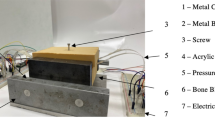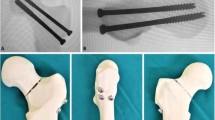Abstract
Screw osteosynthesis using headless compression screws has become the accepted gold standard for the surgical treatment of scaphoid fractures. Optimal screw specifications remain controversially discussed. We aimed to investigate the influence of bone model composition on screw stability tests using headless compression screws in different scaphoid fracture models. We conducted pull-out tests using Acutrak2®mini, HCS®, HKS®, HBS®, Herbert/Whipple® and Twinfix® screws. To imitate cortical and cancellous bone, two-layer polyurethane (PU) models with two distinct densities were produced. The cylinders were cut at different positions to replicate fracture localisations at increasing distances. The maximum pull-out force required to achieve up to 1 mm of pull-out distance (Nto 1 mm) was measured. Acutrak2®mini and HCS® followed by Twinfix® showed the greatest average pull-out forces. Nto 1 mm was, on average, greater in the cortico-cancellous model than in the cancellous cylinder with the Acutrak2®mini and the Herbert/Whipple® screws, while it was the least with the HBS® and the Twinfix® screws; there were also differences between the HCS® and HKS®. There were no differences between the different fracture simulations in the synthesis strength using either the HKS® or HBS®. The pull-out forces of the HCS® and Twinfix® remained high also in simulations with the smaller screw base fragments. Varying imitations of cancellous and cortico-cancellous bone and fracture localisation reveal important information about the ex vivo strength of screw syntheses. The grip of the cortical structure should be used with the screws that fit more firmly in cortico-cancellous bone.





Similar content being viewed by others
Data availability
All relevant data were included to provided tables. The raw datasets generated and/or analysed during the current study are not publicly available due to authors’ decision but are available from the corresponding author on reasonable request.
References
Augat P, Burger J, Schorlemmer S, Henke T, Peraus M, Claes L. Shear movement at the fracture site delays healing in a diaphyseal fracture model. J Orthop Res. 2003;21:1011–7.
Lienau J, Schell H, Duda GN, Seebeck P, Muchow S, Bail HJ. Initial vascularization and tissue differentiation are influenced by fixation stability. J Orthop Res. 2005;23:639–45.
Ramaswamy R, Evans S, Kosashvili Y. Holding power of variable pitch screws in osteoporotic, osteopenic and normal bone: are all screws created equal? Injury. 2010;41:179–83.
Gruszka D, Herr R, Hely H, Hofmann P, Klitscher D, Hofmann A, et al. Impact of Different Screw Designs on Durability of Fracture Fixation: In Vitro Study with Cyclic Loading of Scaphoid Bones. PLoS ONE. 2016;11:e0145949.
Mandaleson A, Tham SK, Lewis C, Ackland DC, Ek ET. Scaphoid fracture fixation in a nonunion model: a biomechanical study comparing 3 types of fixation. J Hand Surg Am. 2018;43:221–8.
Acar B, Kose O, Turan A, Kati YA, Guler F. Single versus double screw fixation for the treatment of scaphoid waist fractures: Finite element analysis and preliminary clinical results in scaphoid nonunion. Jt Dis Relat Surg. 2020;31:73–80.
Patel S, Giugale J, Tiedeken N, Debski RE, Fowler JR. Impact of screw length on proximal scaphoid fracture biomechanics. J Wrist Surg. 2019;8:360–5.
Gruszka DS, Burkhart KJ, Nowak TE, Achenbach T, Rommens PM, Muller LP. The durability of the intrascaphoid compression of headless compression screws: in vitro study. J Hand Surg Am. 2012;37:1142–50.
Crawford LA, Powell ES, Trail IA. The fixation strength of scaphoid bone screws: an in vitro investigation using polyurethane foam. J Hand Surg Am. 2012;37:255–60.
Grewal R, Assini J, Sauder D, Ferreira L, Johnson J, Faber K. A comparison of two headless compression screws for operative treatment of scaphoid fractures. J Orthop Surg Res. 2011;6:27
Brown GA, McCarthy T, Bourgeault CA, Callahan DJ. Mechanical performance of standard and cannulated 4.0-mm cancellous bone screws. J Orthop Res. 2000;18:307–12.
Marter AD, Dickinson AS, Pierron F, Fong YKK, Browne M. Characterising the compressive anisotropic properties of analogue bone using optical strain measurement. Proc Inst Mech Eng H. 2019;233:954–60.
Sugathan HK, Kilpatrick M, Joyce TJ, Harrison JW. A biomechanical study on variation of compressive force along the Acutrak 2 screw. Injury. 2012;43:205–8.
Patel PS, Shepherd DE, Hukins DW. Compressive properties of commercially available polyurethane foams as mechanical models for osteoporotic human cancellous bone. BMC Musculoskelet Disord. 2008;9:137.
Bailey CA, Kuiper JH, Kelly CP. Biomechanical evaluation of a new composite bioresorbable screw. J Hand Surg Br. 2006;31:208–12.
Muhayudin NA, Basaruddin KS, McEvoy F, Tansey A. Evaluating compressive properties and morphology of expandable polyurethane foamfor use in a synthetic paediatric spine. J Mater Res Technol. 2020;9:2590–7.
Chapman JR, Harrington RM, Lee KM, Anderson PA, Tencer AF, Kowalski D. Factors affecting the pullout strength of cancellous bone screws. J Biomech Eng. 1996;118:391–8.
Wheeler DL, McLoughlin SW. Biomechanical assessment of compression screws. Clin Orthop Relat Res. 1998:237–45.
Assari S, Darvish K, Ilyas AM. Biomechanical analysis of second-generation headless compression screws. Injury. 2012;43:1159–65.
Koh IH, Kang HJ, Kim JS, Park SJ, Choi YR. A central threadless shaft screw is better than a fully threaded variable pitch screw for unstable scaphoid nonunion: a biomechanical study. Injury. 2015;46:638–42.
Funding
This study was financed by the Austrian state funding programme Funds to Promote Scientific Research [FWF]) as part of a programme to promote translational studies.
Author information
Authors and Affiliations
Contributions
JE, EU and WM conceptualised and planned the study. JE, EU, IT, AT, PS and AG conducted the experiments. JE, EU, SH and PS analyzed and interpreted the results. MH performed statistical analysis. JE, EU and PS wrote the paper. All authors proof read and approved the paper prior submission.
Corresponding author
Ethics declarations
Conflict of interest
The authors declare that they have no conflict of interest.
Informed consent
All authors have read and approved the final version of the paper for publication.
Additional information
Publisher’s note Springer Nature remains neutral with regard to jurisdictional claims in published maps and institutional affiliations.
Rights and permissions
About this article
Cite this article
Erhart, J., Unger, E., Trulson, I. et al. Pull-out forces of headless compression screws in variations of synthetic bone models imitating different types of scaphoid fractures in good bone quality. J Mater Sci: Mater Med 31, 92 (2020). https://doi.org/10.1007/s10856-020-06445-y
Received:
Accepted:
Published:
DOI: https://doi.org/10.1007/s10856-020-06445-y




